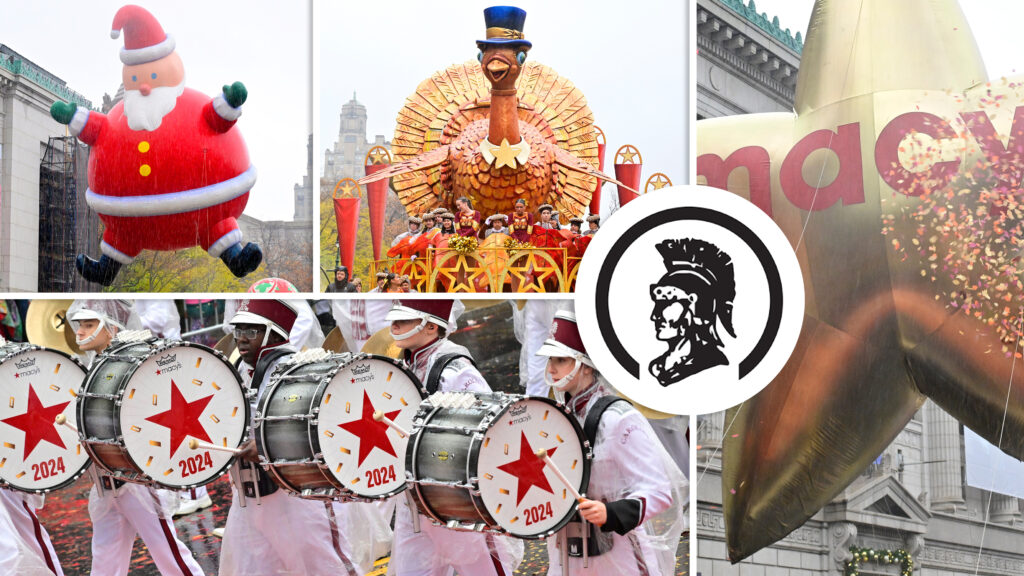Though the temperature at the 1982 Drum Corps International World Championship Finals in Montreal plunged to a frigid 41 degrees Fahrenheit, the Blue Devils stayed hot through the end, becoming the first corps in DCI history to pull off an undefeated season.
Santa Clara Vanguard surprised fans during the Finals competition by throwing in the corps’ famed “Bottle Dance” tag, while the Garfield Cadets finished in the top-three for the first time, just one year prior to winning the DCI title.
PBS stations were once again able to carry the DCI Finals broadcast live after being prevented from broadcasting from Canada in 1981. Venue acoustics were vastly improved over the previous year due to the field being moved back from the stands so sound would not get caught under the cavernous overhang of Olympic Stadium, an edifice that was built for the 1976 Summer Olympics.
Phantom Regiment repeated in fourth place in 1982 with the second consecutive year performing a show based on Aram Khachaturian’s “Spartacus.” Much of the music was reworked by the corps this time around, with some new visual elements added to the production.
Khachaturian, perhaps best known for his “Sabre Dance” from “Gayane,” was an Armenian born in 1903 and was regarded as one of the most important Soviet composers of the era. Despite being strongly pro-Soviet, his music was eventually denounced by the Soviet Department for Agitation and Propaganda as being “anti-people,” which put him in good company with Shostakovich, Kabalev and Prokofiev.
“Spartacus” was Khachaturian’s third and final ballet, written between 1950 and 1954. He was inspired by the story of the gladiator leader of the mass slave uprising against Roman domination that ended in 71 BC, resulting in the total annihilation of the revolting slaves and the mass crucifixion of 6,000 that stretched miles along the Appian Way into Rome.

First staged in 1958 at the Bolshoi Theatre, Khachaturian’s ballet was not a literal interpretation of the Spartacus story. The music of the ballet gained increased popularly after being arranged by the composer in 1955 into four orchestral suites. The titles of each production played by the corps took extensive liberties with those of the original source material, and music from multiple movements of the four suites was combined into some of the on-field movements.
The show opened with “Triumph of Rome.” Color guard members hoisted tall pennants adorned with the emblem of the Roman Empire as a regal fanfare blasted forth. The members of the brass section and drum line wore long red capes as if members of the Roman aristocracy, while the color guard was attired in the slave costumes of the rebellion.
In “Gladiator Fight,” the guard performers tossed red banners into the air to represent the spilling of blood that was typically seen by attendees at gladiator battles. But all was not dreadful and serious, as the jovial “Dance of the Rebels” featured performers playfully tumbling between the dance moves.
One color guard member fighting for life in a gladiator match stabbed another while the brass players watched in a semicircle surrounding the combatants, creating the effect of the audience in the bleachers of the circular Roman Coliseum. This led into the ballad segment, “Prelude to Battle,” where the slaves, chained to each other to prevent escape, threw off their restraints after advancing toward the front, serving notice of their intent to fight the system that enslaved them.
In the segment titled, “Battle,” the color guard members hoisted round shields that were first the red of the Roman centurions and then were reversed to show the purple and white symbol of the slave rebellion, the white being four interlocking circles representing the strength of the different groups of slaves united for the common goal of freedom. This segment referenced the slaves’ battles with the forces of Crassus, the leader of the Roman forces sent by authorities to quash the rebellion.
At the beginning of “Sunrise and Apotheosis,” the guard performers were seen resting on the ground, propped up against each other’s back as the new day dawned. They were woken from their slumber by the Reveille-like bugle calls that announced the closing in of the advancing Roman troops.

This led into a percussion feature, featuring snare drums with split shells. The continuous opening between the upper and lower segments of the shells was a new innovation at the time that was said to contribute to resonance and sound projection.
Giant purple flags with the recurring four interlocking white circles were tossed by the small circle of the guard to the larger surrounding circle of the horn line prior to being tossed back to the guard. The horns, representing the Roman legions, closed in on the slaves to put an end to the rebellion.
With the battle resulting in a victory for the Romans after the suppression of the rebellion, the flags turned a soft purple amidst a white haze, showing the greatly diminished hopes of the rebels.
The show ended with members of the guard bringing forth the unseen body of Spartacus under a covering emblazoned with his likeness. The final moments witnessed a shield being laid over the “body,” the remnants of the force Spartacus had led into battle paying their last respects as they laid to rest the hero that had for a brief time given them the hope of freedom.
1982 Overview

Michael Boo was a member of the Cavaliers from 1975-1977. He has written about the drum corps activity for more than 35 years and serves as a staff writer for various Drum Corps International projects. Boo has written for numerous other publications and has published an honors-winning book on the history of figure skating. As an accomplished composer, Boo holds a bachelor's degree in music education and a master's degree in music theory and composition. He resides in Chesterton, Indiana.





